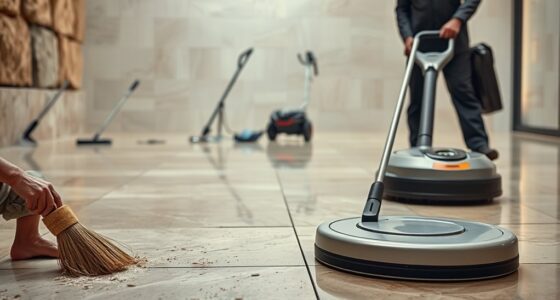To fix your Tennant Floor Scrubber 7400, start by checking for common issues like leaks, clogged filters, and worn squeegee blades. Always prioritize safety by wearing protective gear and ensuring the machine's stable. Regularly inspect and maintain fluid levels and replace worn parts like brushes and the fuel filter. These steps will help maintain performance and efficiency. Keep exploring to uncover more tips and detailed procedures for ideal repairs and maintenance.
Key Takeaways
- Inspect for leaks under the machine, focusing on solution and detergent tanks, and repair any visible damage.
- Check hydraulic fluid levels and quality regularly; replace or refill as needed to ensure optimal performance.
- Replace worn squeegee blades and scrub brush skirts to maintain effective cleaning and water recovery.
- Clean vacuum hoses and solution filters to prevent clogs that can hinder the machine's operation.
- Follow safety precautions, including wearing protective gear and ensuring the machine is stable before performing repairs.
Identifying Common Issues
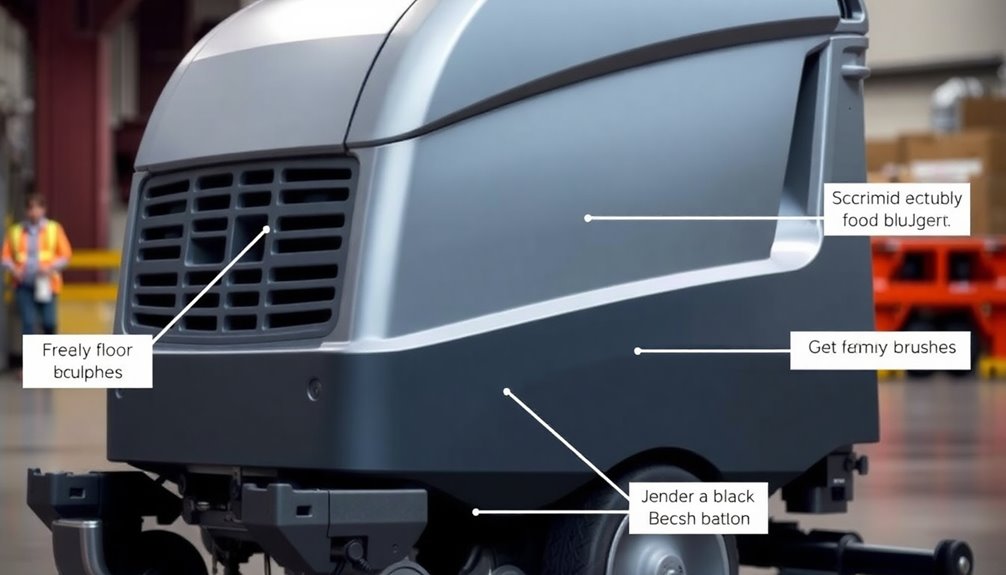
When it comes to maintaining your Tennant Floor Scrubber 7400, identifying common issues early can save you time and costly repairs.
Start by checking for leaks under the machine, especially from the solution tank or detergent tank. These leaks can negatively impact performance.
Regularly inspect the engine air filter and oil levels; a clogged filter or low oil can hinder engine function.
Monitor the hydraulic fluid quality, as improper fluid can lead to hydraulic component failure.
Verify your squeegee blades have proper deflection and contact with the floor; inadequate contact means poor cleaning.
Finally, don't forget to check and clean the vacuum hoses for debris—blockages can greatly reduce suction efficiency and overall cleaning performance.
Safety Precautions Before Repair
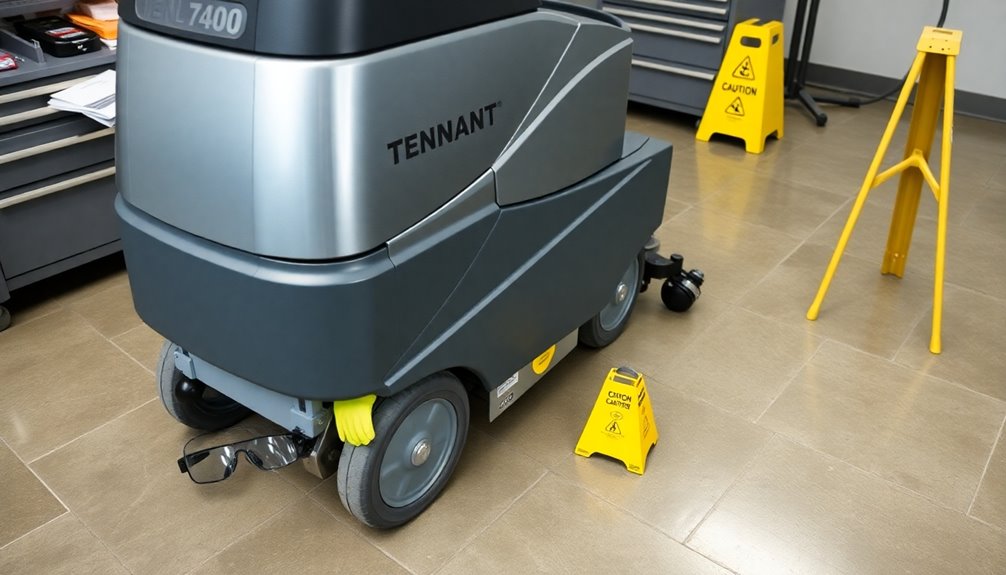
Before you start any repair work on your Tennant Floor Scrubber 7400, it's important to prioritize safety. Here are key precautions to follow:
- Always wear eye protection and ear protection to guard against potential injuries from pressurized air or water.
- Verify the machine is on a level surface and the parking brake is set before beginning repairs.
- Use cardboard to detect any leaking hydraulic fluid; this helps avoid slips and environmental hazards.
- Close the LPG tank's liquid service valve after operation to verify safety during maintenance.
Tools Required for Maintenance

To effectively maintain your Tennant Floor Scrubber 7400, you'll need a few essential tools.
First, grab some Lubriplate EMB grease (Tennant part no. 01433-1) for lubricating the rear wheel bearings and scrub brush idlers.
A hydraulic fluid quality tester is vital for checking your fluid's condition, as using Tennant hydraulic fluid guarantees peak performance.
You'll also need a set of wrenches and sockets to replace parts like the fuel filter every 50 hours and then every 400 hours.
Make sure to have a vacuum cleaner or compressed air handy to clean debris from vacuum hoses and the debris tray after each use.
Finally, don't forget a torque wrench to verify bolts are tightened to manufacturer specifications.
Inspecting the Solution Tank

After gathering the necessary tools for maintenance, it's important to inspect the solution tank on your Tennant Floor Scrubber 7400.
Begin by checking for any visible issues that could hinder performance. Here are key steps to follow:
- Look for leaks or cracks on the tank.
- Make certain the solution tank cover is securely fastened to prevent spillage.
- Inspect the solution filter (ESt filter) for clogs or debris and clean it as needed.
- Verify the tank's 70-gallon capacity and fill it with the appropriate cleaning solution.
Regularly draining and cleaning the solution tank after use helps maintain hygiene and prevents residue buildup.
Keeping an eye on these details guarantees your floor scrubber operates effectively and efficiently.
Cleaning Brushes and Squeegees
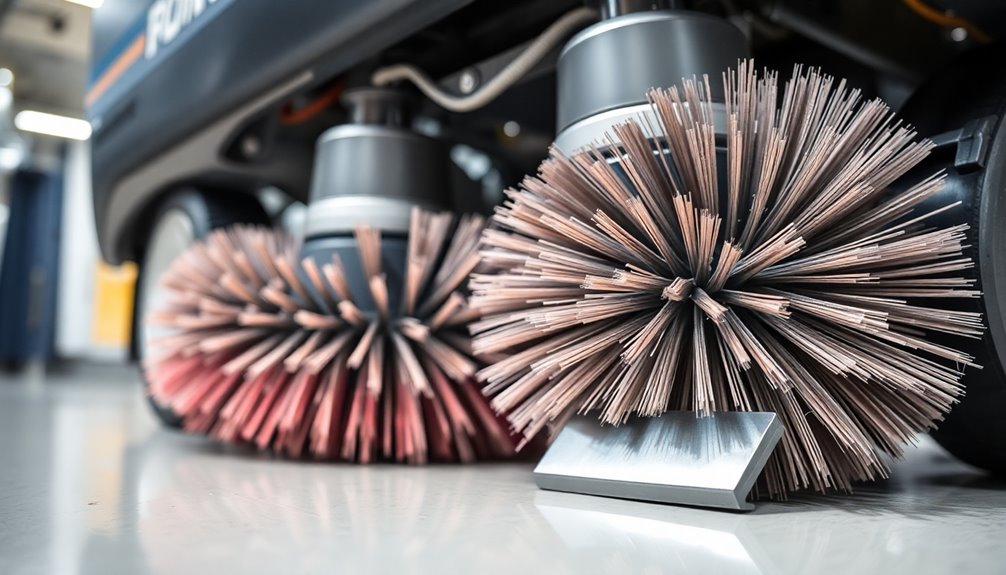
Cleaning brushes and squeegees are essential components of your Tennant Floor Scrubber 7400 that directly impact its performance.
Regularly check the squeegee blade deflection to verify it's making proper contact with the floor for effective water recovery. Inspect the side squeegees for wear or damage every 100 hours to avoid streaking during cleaning.
Don't forget to lubricate each brush idler's grease fitting every 100 hours to guarantee smooth operation. The brush motor operates at 400 rpm, so keep the brushes clean and free of debris for maximum scrubbing efficiency.
Replace any worn or damaged scrub brushes and squeegees promptly to maintain cleaning efficiency and prevent potential floor damage. Always check under the overhead guard to confirm everything's in good condition.
Checking Hydraulic Systems
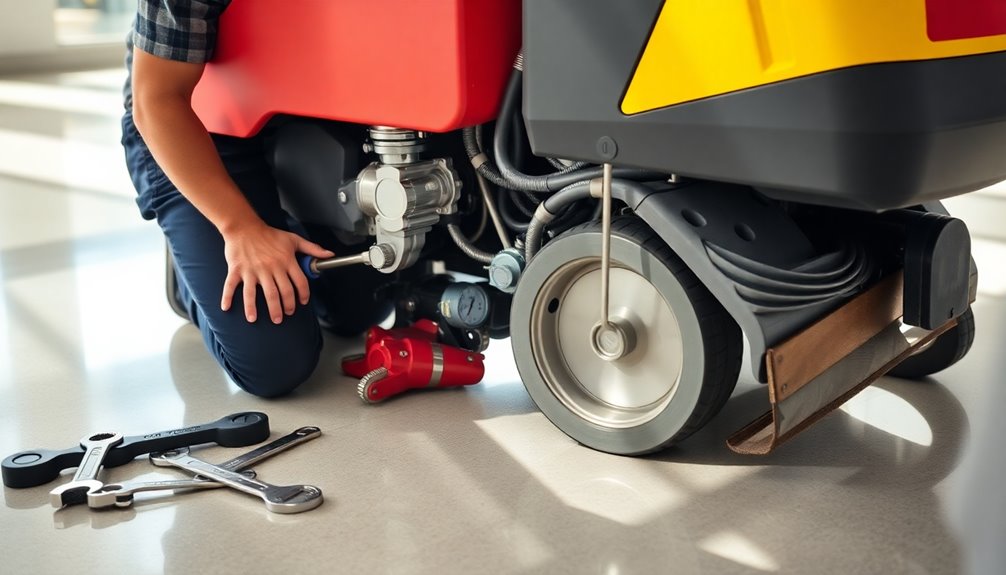
When you're checking the hydraulic systems, start by inspecting the hydraulic fluid levels to guarantee they're where they should be.
Next, look for any leaks around hoses and connections—using cardboard can help you spot any drips easily.
Keeping an eye on these aspects will help maintain your machine's performance and longevity.
Inspect Hydraulic Fluid Levels
Regularly checking hydraulic fluid levels is essential for the best performance of your Tennant 7400 floor scrubber.
Maintaining proper fluid levels not only guarantees peak operation but also prevents potential damage to the machine.
Follow these guidelines for effective inspection:
- Check fluid levels at least every 50 operating hours.
- Use only Tennant-specified hydraulic fluid to avoid premature component failure.
- Confirm the reservoir is filled to the recommended level for proper pressure.
- Refer to the operator manual for specific maintenance procedures and replacement intervals.
Check for Leaks
Checking for hydraulic leaks on your Tennant 7400 is essential for maintaining its performance and preventing costly repairs. Start by inspecting the undercarriage for signs of leaking hydraulic fluid; placing cardboard underneath can help you pinpoint the source.
Next, guarantee all hydraulic hoses and connections are tightly secured and free from wear or damage, as these areas often develop leaks. Regularly monitor the hydraulic fluid level and quality, since low or contaminated fluid may indicate a leak.
If you suspect a leak, carefully examine the hydraulic fluid reservoir for cracks or damage. For accurate identification and repair, consult your operator manual for specific hydraulic system diagrams and troubleshooting steps.
Taking these precautions will keep your machine running smoothly.
Troubleshooting the Drive System

To guarantee your Tennant Floor Scrubber 7400 operates smoothly, troubleshoot the drive system if it becomes unresponsive.
Start by checking a few key components to identify the issue:
- Confirm the brake pedal is fully released; the machine won't move otherwise.
- Inspect the directional pedal for obstructions and confirm it's functioning properly.
- Verify that the battery is fully charged and connections are secure to avoid low power issues.
- Check the hourmeter for maintenance hours; excessive hours may indicate the need for servicing.
Fluid Levels and Filter Maintenance
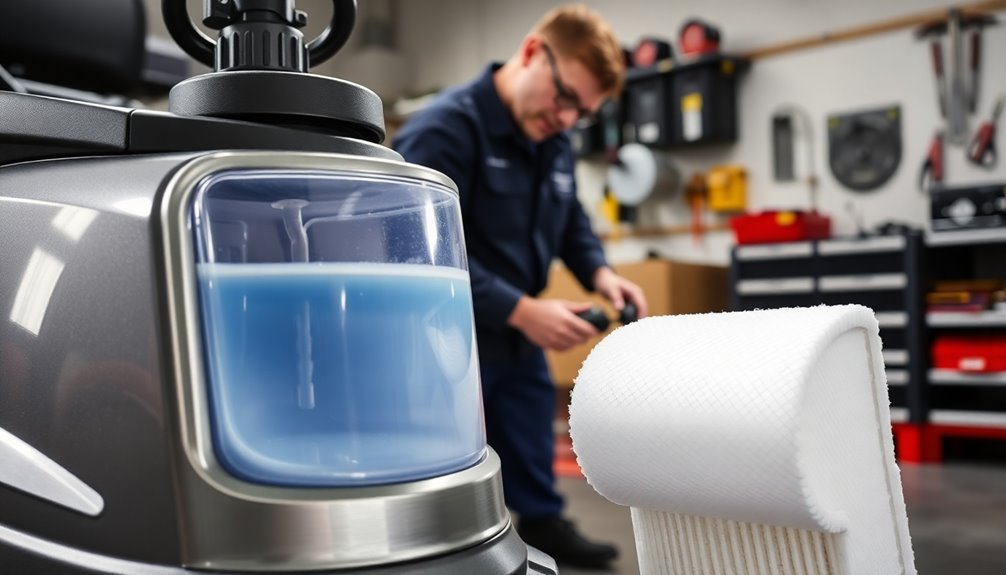
To keep your Tennant Floor Scrubber 7400 running smoothly, you need to regularly check hydraulic fluid levels and maintain the air filter.
Low hydraulic fluid can affect performance, while a clean air filter guarantees proper airflow for the engine.
Stay on top of these tasks to prevent potential issues and enhance efficiency.
Hydraulic Fluid Checks
Hydraulic fluid checks are essential for keeping your Tennant 7400 running smoothly. Regularly inspecting the hydraulic fluid guarantees peak machine operation.
Here are some important points to remember:
- Check the hydraulic fluid reservoir frequently and top off with Tennant-approved fluid as needed.
- Replace the hydraulic fluid filter every 400 hours of operation to maintain system efficiency.
- Use only Tennant hydraulic fluid; substitutes can cause premature failure of components.
- Monitor for leaks or signs of fluid degradation during pre-operation checks to avoid issues.
Air Filter Maintenance
While maintaining your Tennant 7400, air filter maintenance is vital for guaranteeing ideal engine performance.
You should only replace the air filter element when the air filter indicator shows restriction, as this will help optimize engine efficiency.
Regularly check the engine oil level to avoid serious damage; low oil can lead to increased wear.
Remember to clean the crankcase ventilation hose and replace the oil fill cap/PCV breather every 400 hours to prevent buildup.
Flushing the radiator and cooling system every 800 hours is essential to avoid overheating and prolong engine life.
Finally, verify the quality and condition of the hydraulic fluid, using only Tennant hydraulic fluid specifically designed for your machine.
Replacing Worn Parts

Replacing worn parts on your Tennant 7400 is essential for maintaining peak performance and efficiency.
Regular inspections and timely replacements can prevent further issues down the line. Here are some key components to focus on:
- Check scrub brush skirts every 100 hours to make sure they're in good shape.
- Inspect and replace squeegee blades as needed for best water recovery.
- Change the rear grease cavity seal (375-0664) for $42.34 if you notice leaks affecting the hydraulic system.
- Replace the fuel filter every 50 hours, then every 400 hours, to avoid engine performance issues.
Final Testing and Operation
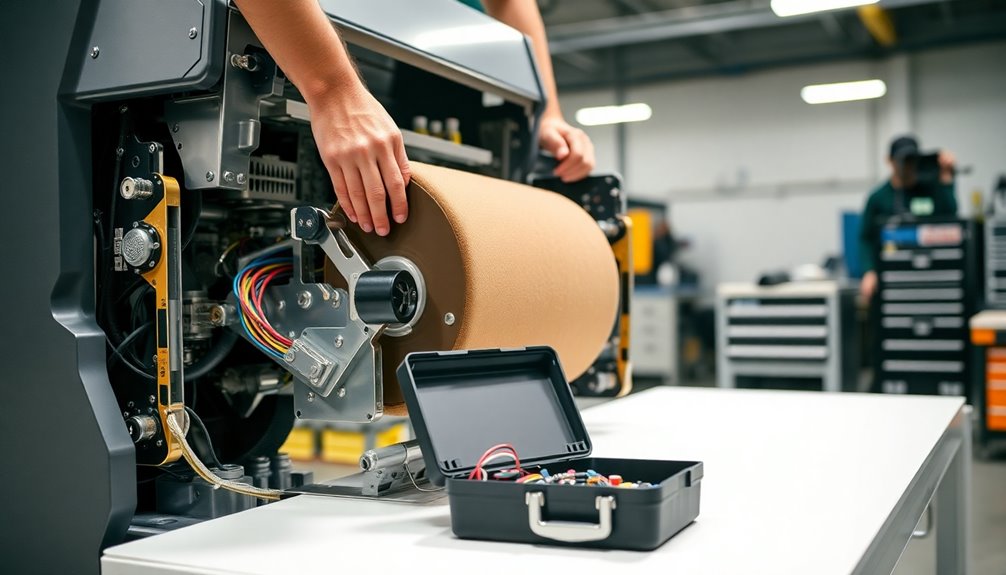
Before you start testing the Tennant 7400, make certain to follow all safety precautions to protect yourself and the equipment.
Once you've confirmed everything's safe, you can move on to verifying its performance through the necessary checks.
This final step is vital to guarantee that your machine operates efficiently and effectively.
Safety Precautions Overview
Guaranteeing your safety during the final testing and operation of the Tennant 7400 floor scrubber is crucial, so always wear eye and ear protection when using pressurized air or water.
Follow these essential safety precautions:
- Set the parking brake and keep the machine on a level surface to prevent movement during checks.
- Use cardboard to locate any hydraulic fluid leaks under pressure, as these can be critical safety issues.
- Confirm the overhead guard is installed in areas where falling objects are a risk, protecting you during operation.
- After use, remember to close the LPG tank's liquid service valve to prevent leaks when the machine isn't in operation.
Performance Verification Steps
To verify the performance of your Tennant 7400 floor scrubber, start by checking key operational components. Confirm the brush motor speed is at 400 rpm for ideal cleaning. Next, inspect the solution and recovery tanks for leaks; the solution tank should hold 70 gallons, while the recovery tank should have a capacity of 72 gallons. Test the propel speed, confirming it can move forward at up to 8 mph and reverse at 4 mph. Don't forget to check the scrub switch for proper activation and use the hourmeter to track operating hours, scheduling maintenance every 50 hours.
| Component | Specification | Action Required |
|---|---|---|
| Brush Motor Speed | 400 rpm | Verify Speed |
| Solution Tank Capacity | 70 gallons | Inspect for Leaks |
| Propel Speed Forward | 8 mph | Test Responsiveness |
| Scrub Switch Operation | Activate Properly | Confirm Functionality |
Frequently Asked Questions
What to Do When the Scrubber Is Not Working?
When your scrubber isn't working, start by checking the pre-operation checklist to confirm everything's filled and leak-free.
Inspect the engine oil pressure light; if it's on, verify the oil level.
Make sure the scrub switch is activated and check the brush motor speed.
If the brushes aren't spinning, there might be an electrical issue.
Finally, examine vacuum hoses for clogs, and consult the operator manual for specific troubleshooting steps.
What Is the Life Expectancy of a Floor Scrubber?
You might think floor scrubbers last forever, but they typically have a life expectancy of 5 to 10 years.
This lifespan hinges on how you use and maintain the machine. Regular maintenance, like lubrication and filter changes, greatly extends its durability.
If you're using it in harsh conditions, expect a shorter life. By following manufacturer guidelines and addressing repairs quickly, you can maximize your scrubber's operational life and get the most out of your investment.
Why Is My Floor Scrubber Not Draining?
If your floor scrubber isn't draining, check a few key areas.
First, confirm the recovery tank is positioned correctly and isn't full.
Next, inspect the vacuum hoses for any clogs or debris that could block water flow.
Don't forget to verify that the squeegee blades are adjusted properly.
Finally, make sure the drain valve is open and functioning.
Regularly clean the ESt filter to prevent clogged filters from causing drainage issues.
How to Reset Tennant T7?
Imagine you're traversing a maze, and the path suddenly blocks your way.
To reset the Tennant T7, first, turn it off and verify it's on a flat surface with the parking brake engaged.
Disconnect the negative battery terminal for at least 10 seconds, then reconnect it.
Check the hourmeter display; it should refresh to zero.
If issues persist, delve into the operator manual for specific error codes that may need your attention.
Conclusion
You've navigated the ins and outs of your Tennant 7400 floor scrubber like a seasoned sailor charting a course through stormy seas. By addressing common issues, performing regular maintenance, and replacing worn parts, you've guaranteed your machine runs smoothly. Now, with your scrubber back in top shape, you can tackle any cleaning job with confidence. Just remember, a well-maintained scrubber is like a trusty compass—it'll guide you to cleaner floors every time!




